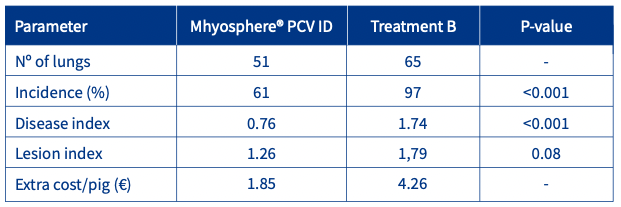
Comparative trial of the lung lesions associated to Mycoplasma hyopneumoniae using artificial intelligence in Greece
The assessment of pulmonary lesions compatible with Enzootic Pneumonia (EP) at the slaughterhouse is the reference technique for assessing the incidence of Mycoplasma hyopneumoniae (Mhyo) and the efficacy of different treatments on swine herds. Recently, HIPRA has developed and validated a new method to assess Mhyo like lesions via artificial intelligence (AI) diagnostic software, called AI Diagnos.
Introduction
The aim of this trial is to compare lung lesions of two different Mhyo vaccination treatments in a Greek swine farm using AI Diagnos.
Materials and methods
The comparative trial was done in a 600-sow farm in Greece, where 323 piglets were vaccinated with Treatment A (Mhyosphere® PCV ID, a new intradermal needle free vaccine against Mhyo and PCV2 all-in-one, at 23 days of age), and 280 piglets were vaccinated with Treatment B (Mhyo intramuscular vaccine at days 20 and 40 of age, and a PCV2 intramuscular vaccine at 28 days of age). Between 50 to 65 animals of each group were randomly selected at slaughter and lung lesions were scored using Artificial Intelligence Diagnos (AI Diagnos).
AI Diagnos is a smart system capable of assessing the score of lesions individually and objectively based on images of lungs using the MADEC modified system1. Different parameters like incidence (percentage of lungs with lesion), disease index (average lesion grade of all lungs), lesion index (average lesion grade of affected lungs), and the extra cost per pig according to Straw et al2., were evaluated. Production parameters were also monitored with the whole treatment group as experimental unit.
Results
Regarding the AI assessment (Table 1), the incidence of Mhyo lesions were lower on Treatment A-Mhyosphere® PCV ID (61%) compared to Treatment B (97%) (p<0,001). Besides that, the disease index of Treatment A-Mhyosphere® PCV ID (0,76) was statistically significantly lower (p<0,001) than treatment B (1,74).

Table 1. Lung parameters by vaccine treatment and statistical analysis. Incidence p-value calculated with a proportion test. P values of lesion index and disease index were calculated with an Anova of an ordinal regression.
The distribution of the lung lesion grades (Figure 1) was different between treatments, with higher percentage of animals with lower lesion grade (Green colors) with Treatment A (Mhyosphere® PCV ID), which consequently affected the extra cost per pig (Table 1) being more than 4 € per pig with Treatment B, and 1.85 € with Treatment A.
ADWG from weaning to slaughter was higher on Treatment A (0,793) compared to Treatment B (0,777) without significant differences.

Figure 1. Distribution of the animals by lesion grade and treatment.
Discussion and Conclusion
Mhyosphere® PCV ID was effective in reducing the lung lesions after vaccination with significant differences on disease index and lesion index, and consequently with lower cost of Mhyo-associated diseases.
References
1- Madec F, Kobisch M (1982) Bilan lesionnel des poumons de porcs charcutiers à l’abattoir [Assessment of lung lesions in fattening pigs at the slaughterhouse]. Journees de la Recherche Porcine [Swine Research Conference], 14, 405e412.
2- Straw BE, Tuovinen VK, Bigras-Poulin M. Estimation of the cost of pneumonia in swine herds. J Am Vet Med Assoc. 1989 Dec 15;195(12):1702–1706.

